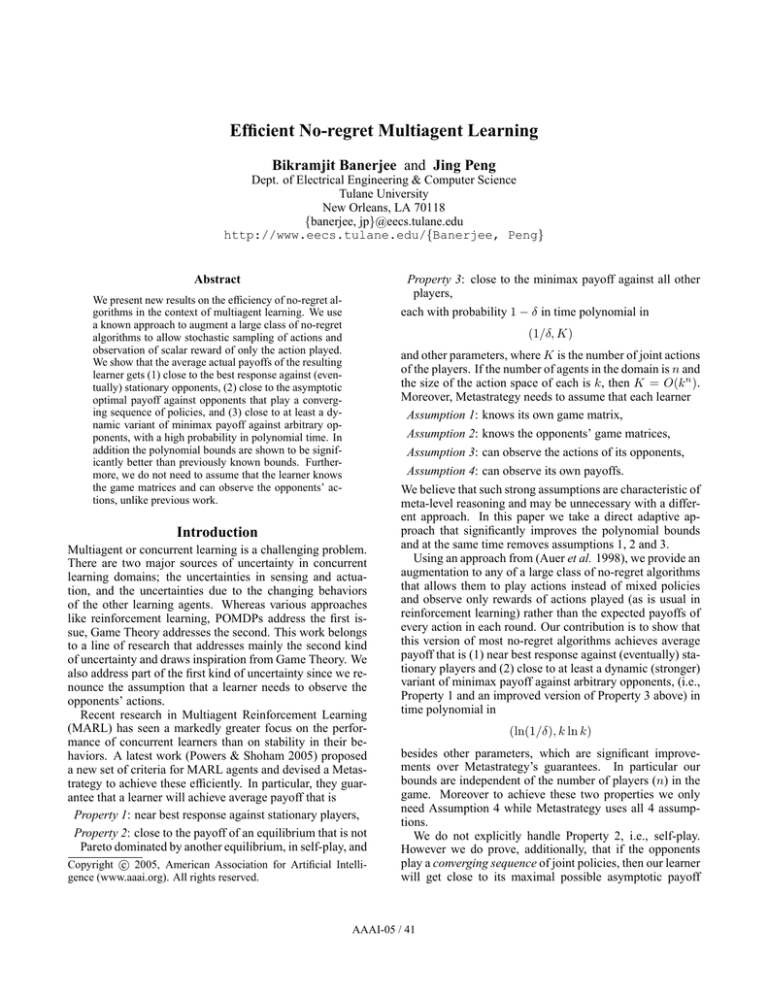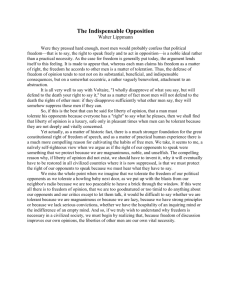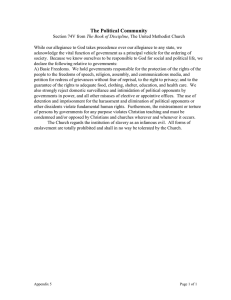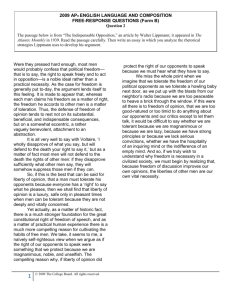
Efficient No-regret Multiagent Learning
Bikramjit Banerjee and Jing Peng
Dept. of Electrical Engineering & Computer Science
Tulane University
New Orleans, LA 70118
{banerjee, jp}@eecs.tulane.edu
http://www.eecs.tulane.edu/{Banerjee, Peng}
Property 3: close to the minimax payoff against all other
players,
each with probability 1 − δ in time polynomial in
Abstract
We present new results on the efficiency of no-regret algorithms in the context of multiagent learning. We use
a known approach to augment a large class of no-regret
algorithms to allow stochastic sampling of actions and
observation of scalar reward of only the action played.
We show that the average actual payoffs of the resulting
learner gets (1) close to the best response against (eventually) stationary opponents, (2) close to the asymptotic
optimal payoff against opponents that play a converging sequence of policies, and (3) close to at least a dynamic variant of minimax payoff against arbitrary opponents, with a high probability in polynomial time. In
addition the polynomial bounds are shown to be significantly better than previously known bounds. Furthermore, we do not need to assume that the learner knows
the game matrices and can observe the opponents’ actions, unlike previous work.
(1/δ, K)
Introduction
Multiagent or concurrent learning is a challenging problem.
There are two major sources of uncertainty in concurrent
learning domains; the uncertainties in sensing and actuation, and the uncertainties due to the changing behaviors
of the other learning agents. Whereas various approaches
like reinforcement learning, POMDPs address the first issue, Game Theory addresses the second. This work belongs
to a line of research that addresses mainly the second kind
of uncertainty and draws inspiration from Game Theory. We
also address part of the first kind of uncertainty since we renounce the assumption that a learner needs to observe the
opponents’ actions.
Recent research in Multiagent Reinforcement Learning
(MARL) has seen a markedly greater focus on the performance of concurrent learners than on stability in their behaviors. A latest work (Powers & Shoham 2005) proposed
a new set of criteria for MARL agents and devised a Metastrategy to achieve these efficiently. In particular, they guarantee that a learner will achieve average payoff that is
Property 1: near best response against stationary players,
Property 2: close to the payoff of an equilibrium that is not
Pareto dominated by another equilibrium, in self-play, and
c 2005, American Association for Artificial IntelliCopyright gence (www.aaai.org). All rights reserved.
and other parameters, where K is the number of joint actions
of the players. If the number of agents in the domain is n and
the size of the action space of each is k, then K = O(k n ).
Moreover, Metastrategy needs to assume that each learner
Assumption 1: knows its own game matrix,
Assumption 2: knows the opponents’ game matrices,
Assumption 3: can observe the actions of its opponents,
Assumption 4: can observe its own payoffs.
We believe that such strong assumptions are characteristic of
meta-level reasoning and may be unnecessary with a different approach. In this paper we take a direct adaptive approach that significantly improves the polynomial bounds
and at the same time removes assumptions 1, 2 and 3.
Using an approach from (Auer et al. 1998), we provide an
augmentation to any of a large class of no-regret algorithms
that allows them to play actions instead of mixed policies
and observe only rewards of actions played (as is usual in
reinforcement learning) rather than the expected payoffs of
every action in each round. Our contribution is to show that
this version of most no-regret algorithms achieves average
payoff that is (1) near best response against (eventually) stationary players and (2) close to at least a dynamic (stronger)
variant of minimax payoff against arbitrary opponents, (i.e.,
Property 1 and an improved version of Property 3 above) in
time polynomial in
(ln(1/δ), k ln k)
besides other parameters, which are significant improvements over Metastrategy’s guarantees. In particular our
bounds are independent of the number of players (n) in the
game. Moreover to achieve these two properties we only
need Assumption 4 while Metastrategy uses all 4 assumptions.
We do not explicitly handle Property 2, i.e., self-play.
However we do prove, additionally, that if the opponents
play a converging sequence of joint policies, then our learner
will get close to its maximal possible asymptotic payoff
AAAI-05 / 41
quickly. We argue that this indirectly addresses self-play
in the following way. If we choose a no-regret algorithm
(base algorithm) that is known (or can be shown) to converge in policies in self-play to an equilibrium profile, and
if they can choose this profile to be non-Pareto dominated,
then our last result will mean that they get close to such an
equilibrium payoff quickly. This is equivalent to Property 2
of Metastrategy, but again with improved dependence on δ
and k. On the flipside, we will possibly need to bring back
assumptions 1 thru 3 depending on which base algorithm we
choose.
Multiagent Reinforcement Learning
A Multiagent Reinforcement Learning task is usually modeled (Littman 1994) as a Stochastic Game (SG, also called
Markov Game), which is a Markov Decision Process with
multiple controllers. We focus on stochastic games with a
single state, also called repeated games. This refers to a scenario where a matrix game (defined below) is played repeatedly between a learner and its opponents. We call the set of
actions available to the learner A, and the set of joint actions
of its n − 1 opponents B. Let k = |A| and potentially all
agents have k actions available, so |B| = O(k n−1 ).
Definition 1 A matrix game for a learner is given by a |A|×
|B| matrix, R, of real values, such that if the learner chooses
action a ∈ A and the opponents choose a joint action profile
b ∈ B, then the payoff of the learner will be R(a, b).
Usually each agent will have a different matrix for its own
payoffs, i.e., ith agent will have its own Ri . A constantsum game (a.k.a competitive games; useful in describing
two agent competitive interactions) is a special matrix game
where for every joint action profile chosen by all agents,
the sum of their payoffs is a constant. If this constant
is zero, then it is also called a zero-sum game. We assume (as in many previous work) that payoffs are bounded,
R(a, b) ∈ [0, rmax ], for real rmax . Table 1 shows an example matrix game for two agents, the Shapley game, with
rmax = 1. Each agent has 3 available actions.
R1 =
1
0
0
Table 1: The Shapley Game.
!
!
0 0
0 1 0
1 0 ,
R2 = 0 0 1
0 1
1 0 0
A mixed policy is a probability distribution over an agent’s
action space. We will represent a mixed policy of the learner
as vector π ∈ ∆(A), and a mixed joint policy of its opponents as the vector ρ ∈ ∆(B). Here ∆ stands for the set of
probability distributions. If the entire probability mass of a
mixed policy is concentrated on a single action j, then it is
also called a pure policy represented as the vector δ j . When
the learner plays a mixed policy π and its opponents play a
mixed policy ρ, the learner’s expected payoff is given by
X
V (π, ρ) =
π(a)ρ(b)R(a, b).
a∈A,b∈B
Definition 2 For an n-player matrix game, the best response of the learner to its opponents’ joint policy (ρ) is
given by BRρ = {π|V (π, ρ) ≥ V (π 0 , ρ), ∀π 0 ∈ ∆(A)}.
Definition 3 The regret of a learner playing a sequence
of policies {π t }t=T
t=1 , relative to any policy π, written as
RT (π) is given by
RT (π) =
t=T
X
t=1
V (π, ρt ) −
t=T
X
V (π t , ρt ).
(1)
t=1
If the sum (over t = 1, . . . , T ) of expected payoffs of the
learner against the actual unknown policies played by the
opponent were compared to that of an arbitrary policy π of
the learner, then the difference would be the learner’s regret.
In hindsight he finds that always playing π instead of the
sequence {π t } would have yielded a total payoff higher than
his actual payoff by RT (π) (possibly negative).
Related Work
Multiagent Reinforcement Learning has produced primarily
two types of algorithms. One type learns some fixed point
of the game e.g., Nash equilibrium (Minimax-Q (Littman
1994), Nash-Q (Hu & Wellman 1998), FFQ (Littman 2001))
or correlated equilibrium (CE-Q (Greenwald & Hall 2002)).
These algorithms can guarantee a certain minimal expected
payoff asymptotically, but it may be possible to guarantee
higher payoff in certain situations if the learner is adaptive to the opponents’ play, instead of learning the game
solution alone. This brings us to the other type of learners that learn a best response to the opponents’ actual
play e.g., IGA (Singh, Kearns, & Mansour 2000), WoLFIGA (Bowling & Veloso 2002), AWESOME (Conitzer &
Sandholm 2003). They assume that the opponents are stationary, or equivalently, learn best response to the empirical distribution of the opponents’ play. WoLF-IGA and
AWESOME also converge to some equilibrium profile in
self-play thus guaranteeing convergence of payoffs as well.
Simple Q-learning (Sutton & Burto 1998) is also capable
of learning a best response to an arbitrary opponent’s policy provided that latter is stationary. There has also been
some work on playing team games (where the game matrices of all agents are identical) (Claus & Boutilier 1998;
Wang & Sandholm 2002) with stronger convergence guarantees owing to the correlation of the game matrices. Most
of these convergence results are in the limit.
One significant line of work that is being increasingly explored recently in MAL is on regret matching
learners. Algorithms have been proposed that achieve
RT (π )
limT →∞ i T i ≤ 0 (called no-regret algorithms) for any
policy π i (Auer et al. 1998; Fudenberg & Levine 1995;
Freund & Schapire 1999; Littlestone & Warmuth 1994).
Their convergence properties were studied in self-play and
found to be incomplete (Jafari et al. 2001), but with additional information, no-regret learning was found to be convergent (Banerjee & Peng 2004). These algorithms usually provide guarantees about asymptotic average expected
payoffs but little is known about their efficiency or about
their average actual payoffs in general. Recent work by
Zinkevich shows that a generalized version of IGA called
GIGA (Zinkevich 2003) has a no-regret property. Similarly a generalized version of WoLF-IGA called GIGA-
AAAI-05 / 42
WoLF (Bowling 2005) has no-regret property with additional policy convergence guarantees against GIGA in small
games. However, these recent algorithms also lack efficiency guarantees as the other no-regret algorithms.
The one work that our paper is most related to (Powers &
Shoham 2005) proposed a new set of properties for a MAL
algorithm, with a greater focus on payoff and efficiency than
policy convergence. We devise a similar learning strategy
based on no-regret algorithms and show that it can provide
efficiency guarantees (for at least 2 of their 3 properties), that
improve significantly upon (Powers & Shoham 2005) with
significantly less assumptions. For the remaining case, we
provide evidence of it being satisfied but possibly at the cost
of similar (large) set of assumptions.
Augmenting a No-regret Algorithm
Usually a no-regret learner observes at each round, a reward
vector that specifies the expected reward of each action if
the mixed policy is played (e.g., GIGA (Zinkevich 2003),
GIGA-WoLF (Bowling 2005), Hedge (Auer et al. 1998)
etc) and outputs a new policy vector, π t+1 . Let the reward
vector that the learner observes for his current policy be x̂t .
Usually π t+1 is computed from x̂t and π t alone, and no extra knowledge (whether about the game or the opponents)
is necessary. An augmenting setup was described in (Auer
et al. 1998) to extend Hedge to allow stochastic sampling
of actions and observation of the reward for only the action
played (Exp3). This allowed the authors to prove that the
average actual payoffs of the learner can be close to playing
the best action with a minimal probability, i.e., lower bounding the per trial gain of the algorithm probabilistically. Actually this strategy can be used in a straightforward way to
augment any no-regret algorithm as we show below.
In this paper we consider
the class of no-regret algorithms
√
that have RT (π) ≤ p T + q for any policy π and for real
values of p, q and p > 0. Usually p,√
q are polynomials of
k and rmax . E.g., for Hedge p = 2 log k, q = 0, for
2
2
GIGA p = (1 + k.rmax
), q = −k.rmax
/2. Most no-regret
algorithms satisfy this form, so the results developed in this
paper apply toPa large class of no-regret algorithms. Now
V (π t , ρt ) = j πjt x̂tj . As a result of this and the assumed
upper bound on regret of this class of no-regret algorithms,
we have from equation 1, for any algorithm of this class
j=k
t=T
XX
πjt x̂tj
t=1 j=1
≥
j=k
t=T
XX
√
πj x̂tj − (p T + q)
(2)
t=1 j=1
for an arbitrary
P Ppolicy π. Note that the set of policies that
maximize t j πj x̂tj consists of at least one pure policy,
i.e., the action which if always played would have given this
maximum payoff sum over t. Therefore the above inequality
can be written as
XX
X
√
πjt x̂tj ≥
x̂ti − (p T + q)
t
j
t
for all i = 1 . . . k. The stochastic augmented module samples the distribution
γ
π̂ t = (1 − γ)π t + 1,
(3)
k
where γ 1 is the probability of exploration, and plays action
jt at time t. It receives the scalar reward xjt for executing
that action and returns to the no-regret algorithm the reward
vector x̂t given by
( x
jt
if j = jt
π̂jt
t
x̂tj =
(4)
0
otherwise
The above compensation scheme for generating a reward
vector based on scalar observation ensures that the expected
gain (i.e. reward aggregate) of any action is proportional to
its actual gain. We call this augmented scheme NoRA (NoRegret with Augmentation). It represents a large class of algorithms and all our results apply to all of them. We call any
agent following any algorithm from this class, a NoRA agent
or a NoRA learner.
P t t
xjt
xjt
Now since
j πj x̂j = πjt π̂jt ≤ 1−γ (from equations 3,4), we have from equation 2
X
X
√
xjt ≥ (1 − γ)
x̂ti − (1 − γ)(p T + q), ∀i.
t
t
t
t xi
P
If
is the actual gain of action i thru T, then from
lemma 5.1 of (Auer et al. 1998) 2 we know that for 1 >
λ, δ > 0 and for any i, with probability at least 1 − δ/2
X
kλ X t rmax ln(2k/δ)
t
x̂i ≥ 1 −
xi −
γ
λ
t
t
This is a slightly weaker bound than (Auer et al. 1998) but
is sufficient for our purpose. It is also slightly more general
because unlike (Auer et al. 1998), we do not need to assume
rmax = 1. Combining the last two inequalities we have for
all i = 1, . . . , k, with probability at least 1 − δ/2,
X
t
xjt
≥
kλ
(1 − γ)rmax ln(2k/δ)
− γ)xti −
γ
λ
t
√
−(1 − γ)(p T + q)
(5)
X
(1 −
This is a basic property of any NoRA agent. At this point
there is insufficient information to provide tight bounds on
the regret. With further algorithm-specific assumptions,
2
Exp3 achieves O(T 3 ) regret bound. There is also current
interest in gradient estimation (as in equation 4) in partial information settings. For instance, (Flaxman, Kalai, & McMahan 2005) provide an alternate gradient estimation procedure based on scalar feedback similar to our setup, which al3
lows a regret bound of O(T 4 ) for the corresponding version
of GIGA. However, our purpose is not to tightly bound the
regret; rather we wish to establish opponent-dependent polynomial time bounds on the accumulated rewards for which
equation 5 is a sufficient starting point. Using it we show
in the following sections, that the average actual rewards of
1
The addition of a uniform exploration component is necessary
to obtain good actual payoffs in any single run, in contrast with just
obtaining good payoffs in expectation.
2
The proof of Lemma 5.1 does not depend on the specifics of
Hedge, only those of the augmented module of Exp3, which we
adopt in a general way.
AAAI-05 / 43
any NoRA learner will satisfy Property 1,3 and also be close
to the the maximum possible asymptotic payoff against converging opponents, with a high probability in polynomial
time.
(Eventually) Stationary Opponents
Eventually stationary opponents are those that play stationary policies after some finite (but unknown) time t0 . If an algorithm is guaranteed to attain near best response against opponents that are always stationary in polynomial time, then
it should not be harder to guarantee the same against eventually stationary opponents with at most an extra polynomial
dependence on t0 . Hence in the following, we consider stationary opponents. Let ρ be the fixed joint distribution of
the opponents, and VBR be the value of the learner’s best
response.
max
Theorem 1 For > 2γr
γ+1/2 , δ > 0, there exists a T0 polynomial in (1/, ln(1/δ), rmax , k ln k) such that if the game
is played for at least T0 rounds, a NoRA agent will achieve
an average actual payoff of at least VBR − against n − 1
stationary players, with probability at least 1 − δ.
Proof : If the opponents are sampling actions from fixed
distributions, then the xti ’s in RHS of equation 5 are i.i.d
with mean VBR if δ i ∈ BRρ . By Azuma’s Lemma
Pt=T
2
1
P ( T11 t=1 1 xti ≥ VBR − /2) ≥ 1 − exp( −T
). Set8r 2
in the conclusion section. Also note that the value of T0 will
be proportional to 1/γ; so if γ is held to a small constant
(which can be done independently of the game or the opponents) to allow a small , the constants of the polynomial expression will be large. However, the advantages of this result
over Metastrategy are more compelling. The dependence
of NoRA is on ln(1/δ) instead of 1/δ and k ln k instead
of k n . 3 Furthermore such a learner does not need to observe the opponents’ actions or know its own game matrix,
whereas both of these assumptions are needed in (Powers &
Shoham 2005) to produce the guarantees against stationary
opponents, and all of Assumptions 1-4 are used. NoRA only
needs Assumption 4. All these advantages (as well as the
limitation due to exploration) also apply to all results developed in the rest of the paper.
Converging Opponents
If the opponents’ joint policy converges in Cauchy’s sense,
then for any given > 0 there exists a time t such that
∀t1 , t2 > t , kρt1 − ρt2 k < . In other words, there exists
a region of diameter in the joint policy space, N , such
that ∀t > t , ρt ∈ N . The policy sequence converges to the
center of this “ball”, but we do not need to know the location
of this ball in the policy space, just the fact that it exists. We
call π BR(ρ) any best response policy of the learner to the
opponents joint policy ρ. Then,
max
8r 2
ln(2/δ)
ting this to be at least 1 − δ/2, we have T1 ≥ max2
,
a polynomial in (rmax , ln(1/δ), 1/). Also for all T2 > 0,
with probability at least (1 − δ/2)2 ≥ (1 − δ), we have from
equation 5
t=T
1 +T2
X
xjt
≥ (1 −
t=1
kλ
− γ)(T1 + T2 )(VBR − /2)
γ
(1 − γ)rmax ln(2k/δ)
λ
√
−(1 − γ)(p T + q)
−
Since we are free to choose any admissible value for 1 >
λ > 0 we let λ = γ 2 /k. Taking average from the above, we
see it is at least
(1 − γ)rmax k ln(2k/δ)
(1 − 2γ)(VBR − /2) −
γ 2 (T1 + T2 )
√
(1 − γ)(p T1 + T2 + q)
−
T1 + T2
Clearly, it is necessary that γ < 0.5, i.e., majority of
the probability mass should be concentrated on exploitation
rather than exploration. Actually γ should be set to a fixed
max
small value. Then for > 2γr
γ+1/2 , setting the above expression for average value at least VBR − , we get a quadratic
of the form of ax2√− bx − c = 0 with a, b, c > 0, for the
minimal value of T1 + T2 . So a real solution exists and
the theorem follows for T0 = T1 + T2 .
The limitation of this result is that it does not hold for evmax
ery > 0, only for every > 2γr
γ+1/2 . This is the price of
never ceasing to explore. We discuss this limitation further
Vmax = max V (π BR(ρ) , ρ)
ρ∈N
is asymptotically the optimal payoff the learner might receive. We show that the average actual payoff of a
NoRA learner will be α-close to this value, in time polynomial in (1/α, t , ln(1/δ), rmax , k ln k). This is a nonintuitive result since the opponents are not assumed to settle
to any fixed policy in finite time, only in the limit. The theorem says, regardless of the actual policy that the opponents
approach asymptotically (which will hence be unknown at
all finite times), the learner’s average payoff will be close to
the best possible asymptotic payoff in polynomial time.
This result is useful, for instance, against opponents that
want to learn some fixed properties of the game through
exploration disregarding how its opponents behave, similar
to the equilibrium learners Minimax-Q, Nash-Q, CE-Q etc.
Here NoRA would efficiently learn the value of the equilibrium, depending on t which is tied to the computational
complexity of the equilibrium. Therefore, NoRA does not
produce a way (per se) to efficiently compute an equilibrium,
the complexity of which remains an open problem. Another
interesting case is when two no-regret algorithms are guaranteed to converge in policies, e.g., GIGA-WoLF (Bowling 2005) (known to converge against GIGA, also a noregret algorithm) and ReDVaLeR in self-play (Banerjee &
Peng 2004). Our result implies that in such cases, the average actual payoffs of both players (augmented to produce NoRA agents) will be close to the equilibrium payoff
quickly, assuming that convergence continues to hold with
3
(Powers & Shoham 2005) use the symbol k to represent the
size of the joint action space which is O(kn ) in our notation.
AAAI-05 / 44
augmentation. Then this result can also be interpreted as
showing that the rate of convergence of these algorithms
cannot be worse than a polynomial factor of 1/t .
α
Theorem 2 Let δ > 0, α > 0 and < rmax (1−3γ)
.
This implies a t . Then there exists a T0 polynomial
in (1/α, t , ln(1/δ), rmax , k ln k) such that if the game is
played for at least T0 rounds, a NoRA agent will achieve
an average actual payoff of at least Vmax − α against n − 1
convergent players, with probability at least 1 − δ.
Proof : Let ρ0 = arg maxρ∈N V (π BR(ρ) , ρ). Now we
know that BRρ0 contains at least one pure policy, since any
action in the support of a best response is also a best response. Let δ i0 ∈ BRρ0 , and T > t . The main difference
with the previous case of stationary opponents is that xTi0 are
not i.i.d. All we know is that
EjT [xTi0 |jt +1 , . . . , jT −1 ] ≥ Vmax − rmax ,
since ρTj ≥ ρ0j − for all j. But employing the approach of
Lemma 5.1 in (Auer et al. 1998) (adapted from Neveu) we
can show that
!
t=T
t=T
2
X
λ0 X
λ0
t
t
t
ZT = exp
rmax
(E[xi0 ] − xi0 ) −
t=t +1
rmax
E[xi0 ]
t=t +1
forms a supermartingale sequence, and that E[ZT ] ≤ 1.
Then by Markov inequality we have P (ZT > 2/δ) ≤ δ/2.
Therefore, with probability at least 1 − δ/2
t=T
X
xti0
t=t +1
0
≥ (1 − λ )
t=T
X
(Vmax − rmax ) −
t=t +1
rmax
ln(2/δ)
λ0
Combining with equation 5 (where λ is replaced by γ 2 /k
as in previous section) we get with probability at least 1 − δ,
t=T
X
t=1
xjt
≥ (1 − 2γ)
t=t
X
xti0
t=1
+(1 − 2γ)[(1 − λ0 )(T − t )(Vmax − rmax )
rmax
(1 − γ)rmax k ln(2k/δ)
− 0 ln(2/δ)] −
λ
γ2
√
−(1 − γ)(p T + q)
≥ 0 + (1 − 2γ − λ0 )(T − t )(Vmax − rmax )
rmax (1 − 2γ) ln(2/δ)
−
λ0
(1 − γ)rmax k ln(2k/δ)
−
γ2
√
−(1 − γ)(p T + q)
Choosing λ0 = γ and setting the RHS of the average from
above, to be at least V√max − α we again end up with a
quadratic for minimal T of the form ax2 − bx − c = 0
where b, c > 0 and a = −rmax − 3γVmax + 3γrmax + α.
α
Clearly, a > 0 if < rmax (1−3γ)
and hence if also γ < 1/3.
Then a real solution exists and the Theorem follows.
Note that we do not assume the exact form of dependence
of t on . If t is a polynomial of 1 then the Theorem will
involve 1 instead of t . However, if t happens to be a worse
function of 1 then it will dominate any polynomial in 1 ,
therefore our guarantee will be in terms of t and not 1 .
Since how close the learner gets to Vmax cannot be independent of how close the opponents’ are to their asymptotic
behavior, will have to be chosen smaller than some function of α. The above theorem allows this function to be no
worse than linear. A more technical way of interpreting this
dependence goes as follows: since it is not guaranteed that
limt→∞ ρt = ρ0 , the asymptotic payoff of the learner may
be lower than Vmax . Hence the uncertainty in its payoff, α,
must incorporate the uncertainty in the opponents’ asymptotic policy relative to ρt which cannot be larger than for
t > t .
Arbitrary Opponents
When the opponents can play arbitrary sequence of policies,
no-regret learning ensures that the expected average payoff
will not be much worse than that of the best response to the
opponents’ empirical distribution. Though this can be no
worse than a minimax 4 or security value of the game, it can
possibly be better. We define a variant of the minimax solution that depends on the opponents’ policies, called Opponent Dependent MiniMax or ODMM. This is produced in the
same way as minimax, but allowing minimization over the
actual sequence of opponent strategies rather than the entire
space of opponent strategies. Therefore, if VODM M is the
expected ODMM payoff and VM M is the expected minimax
payoff, then
VODM M ≥ VM M .
In this section we show that with a high probability a
NoRA agent will obtain actual payoffs close to at least
VODM M , in polynomial time. Note that this is a stronger
guarantee than Property 3, and is another advantage of our
adaptive strategy over meta-level reasoning that can only use
the knowledge of the game’s fixed minimax solution for security.
Theorem 3 Let > 3γrmax , δ > 0. Then there exists a
T0 polynomial in (1/, ln(1/δ), rmax , k ln k) such that if the
game is played for at least T0 rounds, a NoRA agent will
achieve an average actual payoff of at least VODM M − against n − 1 players using arbitrary sequence of policies,
with probability at least 1 − δ.
Proof : In this case we have even less information about the
opponents’ policies than the previous two sections. Also, the
xti ’s are not necessarily i.i.d. as in the previous section. Let
η be any mixture over the learner’s action space, A. Using
this we can mix equation 5 for all i = 1, . . . , k (with the
previous choice of λ = γ 2 /k) to get
X
X
(1 − γ)rmax k ln(2k/δ)
xjt ≥
(1 − 2γ)(η · xt ) −
γ2
t
t
√
−(1 − γ)(p T + q)
4
Although minimax solutions of two player games are welldefined, it is less concrete for n-player games due to the possibility
of collaboration among opponents. We assume all opponents are
playing individually without forming coalitions.
AAAI-05 / 45
since
P
i
ηi = 1. Then we note that
Ejt [η · xt |j1 , . . . , jt−1 ]
= η · R · ρt
≥
min η · R · ρt
{ρt }
Since this holds for arbitrary η, it also holds for the η that
maximizes the RHS above, which means
Ejt [η · xt |j1 , . . . , jt−1 ] ≥ VODM M
no matter what sequence of policies the opponents play.
Then following the same approach of constructing a supermartingale sequence as in the last section, we get the result.
Conclusion
We have presented a new class of MARL algorithms,
NoRA , by employing a known appraoch of stochastization
on a large class of no-regret algorithms. We have shown
that its average actual rewards will be close to optimal,
with high probability, for two classes of opponents in time
polynomial with improved bounds relative to existing results. NoRA also makes minimal assumptions unlike previous approaches. We have also shown that a NoRA agent
achieves near optimal average reward, with high probability
in polynomial time, against opponents that play converging
sequence of policies. The main limitation of NoRA is that it
needs to use a low probability of exploration to allow meaningful bounds. It may be given the value of exploration probability with the knowledge of rmax (which then becomes an
assumption, still significantly weaker than Assumption 1),
and then the values of payoff uncertainties can be lowered
to any desired value thus allowing useful bounds. If this
knowledge is not available, NoRA may select some small
value for γ on its own, without adding to its list of assumptions. But then the guarantees only hold for uncertainty (in
payoff) values that are larger than some linear functions of
γ, which might make the bounds less useful. One possible
future work is to try a decaying schedule for γ instead of a
constant. We also intend to test NoRA in repeated games to
estimate the values of the constants involved in the polynomial bounds, and compare with Metastrategy.
Acknowledgements
The authors gratefully acknowledge the valuable inputs
from anonymous reviewers. This work was supported in part
by Louisiana BOR Grant LEQSF(2002-05)-RD-A-29.
References
Auer, P.; Cesa-Bianchi, N.; Freund, Y.; and Schapire, R. E. 1998.
Gambling in a rigged casino: The adversarial multi-armed bandit problem. Technical Report NC2-TR-1998-025, NeuroCOLT2
Technical Report Series.
Banerjee, B., and Peng, J. 2004. Performance bounded reinforcement learning in strategic interactions. In Proceedings of the
19th National Conference on Artificial Intelligence (AAAI-04), 2–
7. San Jose, CA: AAAI Press.
Bowling, M., and Veloso, M. 2002. Multiagent learning using a
variable learning rate. Artificial Intelligence 136:215 – 250.
Bowling, M. 2005. Convergence and no-regret in multiagent
learning. In Proceedings of NIPS 2004/5.
Claus, C., and Boutilier, C. 1998. The dynamics of reinforcement
learning in cooperative multiagent systems. In Proceedings of
the 15th National Conference on Artificial Intelligence, 746–752.
Menlo Park, CA: AAAI Press/MIT Press.
Conitzer, V., and Sandholm, T. 2003. AWESOME: A general multiagent learning algorithm that converges in self-play and
learns a best response against stationary opponents. In Proceedings of the 20th International Conference on Machine Learning.
Flaxman, A.; Kalai, A.; and McMahan, H. 2005. Online convex optimization in the bandit setting: Gradient descent without
a gradient. In Proceedings of the Sixteenth Annual ACM-SIAM
Symposium on Discrete Algorithms (SODA). To appear.
Freund, Y., and Schapire, R. E. 1999. Adaptive game playing using multiplicative weights. Games and Economic Behavior 29:79
– 103.
Fudenberg, D., and Levine, D. 1995. Consistency and cautious fictitious play. Journal of Economic Dynamics and Control
19:1065 – 1089.
Greenwald, A., and Hall, K. 2002. Correlated q-learning. In
Proceedings of the AAAI Symposium on Collaborative Learning
Agents.
Hu, J., and Wellman, M. P. 1998. Multiagent reinforcement learning: Theoretical framework and an algorithm. In Proc. of the 15th
Int. Conf. on Machine Learning (ML’98), 242–250. San Francisco, CA: Morgan Kaufmann.
Jafari, A.; Greenwald, A.; Gondek, D.; and Ercal, G. 2001. On
no-regret learning, fictitious play, and nash equilibrium. In Proceedings of the Eighteenth International Conference on Machine
Learning, 226 – 223.
Littlestone, N., and Warmuth, M. 1994. The weighted majority
algorithm. Information and Computation 108:212 – 261.
Littman, M. L. 1994. Markov games as a framework for multiagent reinforcement learning. In Proc. of the 11th Int. Conf. on
Machine Learning, 157–163. San Mateo, CA: Morgan Kaufmann.
Littman, M. L. 2001. Friend-or-foe Q-learning in general-sum
games. In Proceedings of the Eighteenth International Conference on Machine Learnig.
Powers, R., and Shoham, Y. 2005. New criteria and a new algorithm for learning in multi-agent systems. In Proceedings of NIPS
2004/5.
Singh, S.; Kearns, M.; and Mansour, Y. 2000. Nash convergence
of gradient dynamics in general-sum games. In Proceedings of
the Sixteenth Conference on Uncertainty in Artificial Intelligence,
541–548.
Sutton, R., and Burto, A. G. 1998. Reinforcement Learning: An
Introduction. MIT Press.
Wang, X., and Sandholm, T. 2002. Reinforcement learning to
play an optimal nash equilibrium in team markov games. In Advances in Neural Information Processing Systems 15, NIPS.
Zinkevich, M. 2003. Online convex programming and generalized infinitesimal gradient ascent. In Proceedings of the 20th
International Conference on Machine Learning.
AAAI-05 / 46





